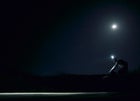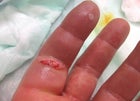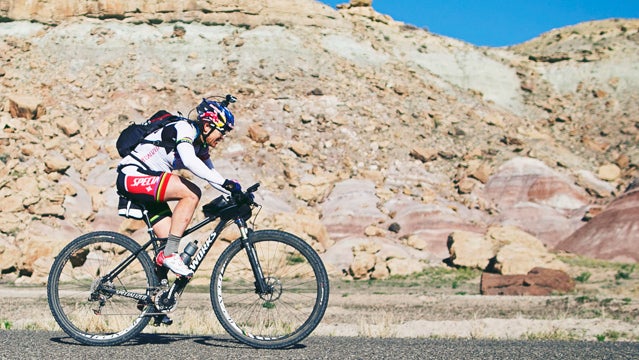Last week, again proved themselves masters of hype with the release of their video, “.” It’s ostensibly a documentary about Rusch’s record-setting run in late April on the 142-mile trail between Moab, Utah, and Fruita, Colorado.
 Rusch before her light failure.
Rusch before her light failure. Rusch’s painful finger injury.
Rusch’s painful finger injury.Some producer should get a job in Hollywood for this one. Not only does the video distill Rusch’s 13-hour, 32-minute, and 47-second record ride into four scintillating minutes, but it injects endurance mountain biking, which, let’s face it, is more about solitary plodding than sensational speed, with a real sense of urgency and drama.
Watch carefully, however, and you’ll quickly realize this clip is true theater. Though it’s cut and billed as coming from the record ride, there’s no way most of the footage was captured on race day.
Castle Valley in afternoon light? Based on her times, Rusch passed here in complete darkness. Headlights in the pre-dawn? Rusch said that her lights died at 4 a.m. and she had to ride by moonlight till sunrise. As for the scenes where she’s flat-out sprinting (1:12) and—comically—running uphill with her bike on her back (1:40), the reality is that a long effort like this takes steady pacing not VO2 max efforts.
When I asked Rusch about it she just laughed. “Yeah most of the video was shot the day after, with me wearing the same clothes as I raced in,” she said.
Let’s be clear: The point isn’t whether or not Rusch accomplished the ride and set a new record time in doing so. She has the GPS file to prove her performance and years of mountain bike and adventure racing cred to back it up. The result itself is truly remarkable. Not only did she knock almost an hour-and-a-half off the previous best women’s time, but she did it faster than all but a handful of men before her, including Jesse Jakomait, who currently holds the overall record of 12:18. And her powerfile only underscores the accomplishment. Thirteen-plus hours of riding with a speaks for itself.
Along the way, Rusch overcame some real obstacles on her way to the record. A crash after less than three hours dislocated her finger so far back that it ripped the skin on the inside of her digit. And a headlight failure in the early morning had her riding for hours by moonlight.
That’s what’s so ridiculous about the video. It injects theatrics where real drama already existed. To be fair, some of that is unavoidable. Endurance racing rules mandate solo efforts. So there’s no fair way to capture the true experience—at least not in glorious, saleable hi-def. Rusch knew this and wisely declined having a film team follow her throughout.
But the crew met her at multiple stops on the course to film, which raises the question: How much help—even if it was only psychological—did she get? Rusch insists she was a stickler for the rules (“I even made the cars turn out their lights when I got near so I wouldn’t know which way to go,” she explained), and I believe her. But having a team out there in a car looking for you definitely introduces a safety net that many endurance racers would say changes the game. Do you go harder and take more risks if you know that help isn’t far if you need it?
It’s a shift that’s hard to avoid with commodification, and you have to respect Rusch for figuring out a way to get paid to take on killer adventures like the Kokopelli Trail. Hopefully, though, the introduction of media and cars on the course and videos with concocted narrative lines won’t erode the principles of trust and self-reliance on which the sport is built.
In the trailer, Rusch reads from a breathless script: “It’s me, alone, in my own world. Complete isolation.” That’s a great description of endurance racing, and I’m sure it accurately describes what Rusch went through to set this impressive record. But it’s hard not to roll your eyes a little bit at the thought of the video team just out of the frame or the scrum of spectators that Red Bull rounded up at the finish—complete with champagne.


